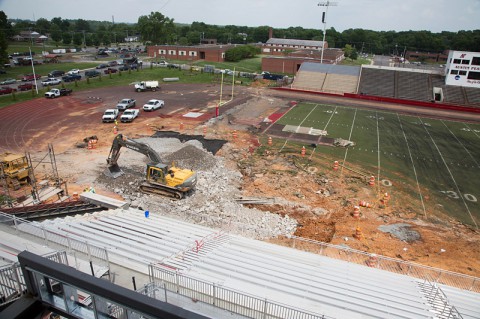 Clarksville, TN – Construction crews are now remediating a large sinkhole discovered a few months ago during construction of the new Governors Stadium. The hole, identified in March when construction crews installed underground utilities, was relatively small, measuring only a few feet across.
Clarksville, TN – Construction crews are now remediating a large sinkhole discovered a few months ago during construction of the new Governors Stadium. The hole, identified in March when construction crews installed underground utilities, was relatively small, measuring only a few feet across.
However, once work began to remediate the sinkhole, workers encountered unstable soil conditions that required an excavation more than 40 feet deep.

Campus officials expect construction crews to have it safely remediated by early next week. The Governors Stadium project includes contingency funds for handling unknown construction conditions, such as sinkholes.
The sinkhole will not delay the project, with the Governors’ football home opener still scheduled to take place in the newly renovated stadium on September 13th.
While the scale of the sinkhole was a surprise to University officials, sinkholes are relatively common in this area. The Austin Peay State University campus landscape highlights several sinkholes.

Referred to as “The Bowls,” the center point of campus features two large remediated sinkholes that have been part of the landscape since the University was founded in 1927. Harned Hall, the oldest academic building on campus, features a bowl with the University logo in the center as part of its landscaping.
Most of Middle Tennessee and Central Kentucky are comprised of karst topography. According to information from the United States Geological Survey (USGS) website, karst topography is a terrain with distinctive landforms and hydrology created from the dissolution of soluble rocks, principally limestone and dolomite.
The area is part of the Midwest Paleozoic Carbonate Aquifers that range from the Great Lakes region in Northern Michigan to Northern Alabama and cover the vast majority of the Middle Tennessee area. Clarksville and Montgomery County sit on top of large beds of rich limestone, making this region prone to sinkholes.
For a current photo gallery, updates, or to view a live video stream of progress on the stadium and the sinkhole remediation, please visit www.apsu.edu .


